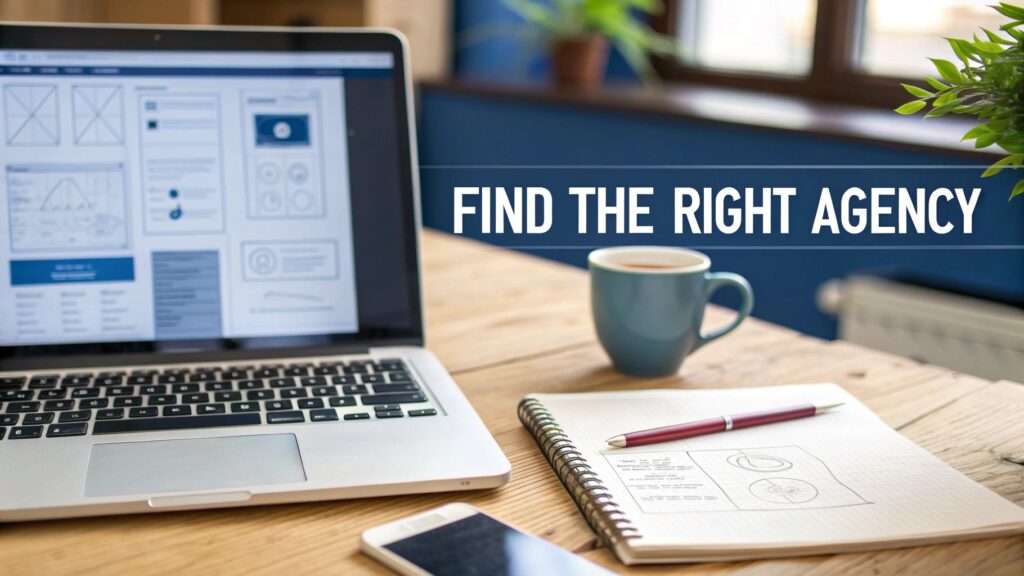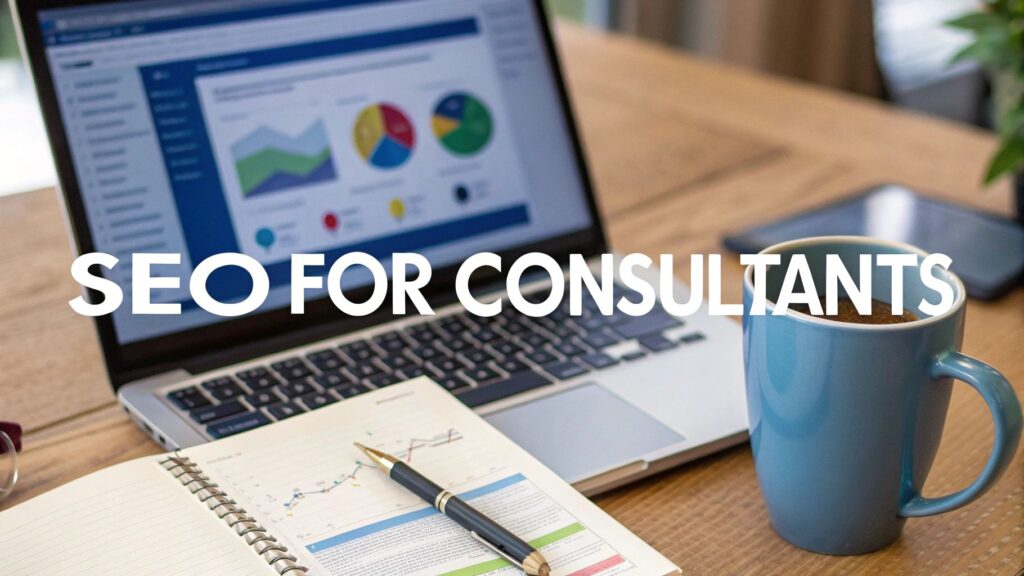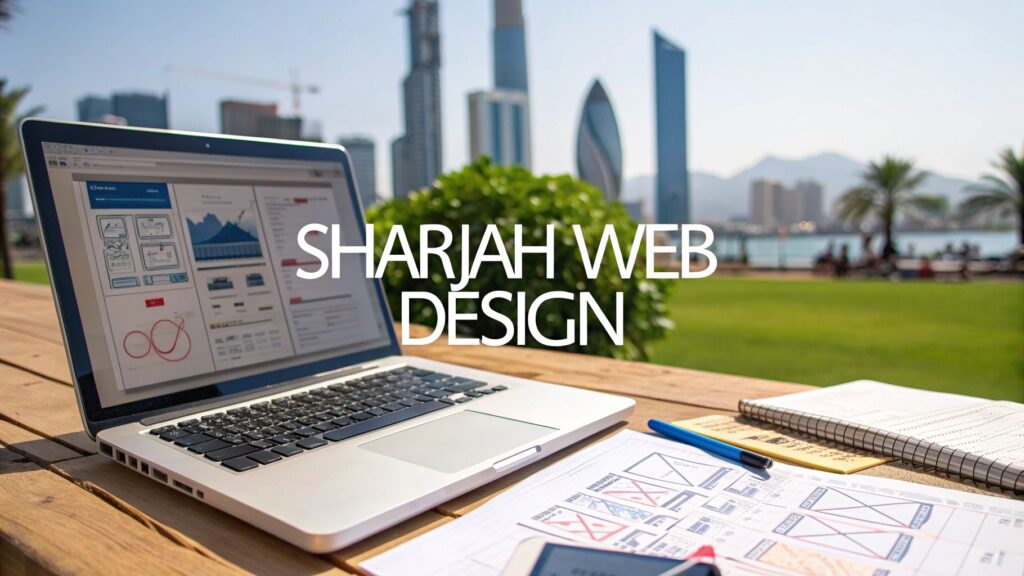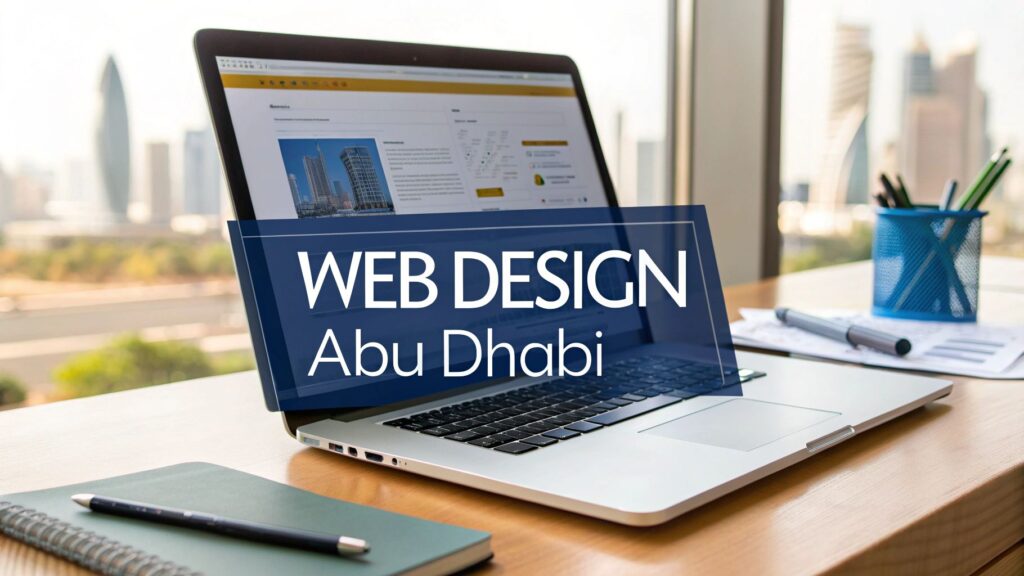A website design agency is more than just a group of coders and artists; they’re a strategic partner. Think of them as a team of specialists—strategists, designers, developers, and marketers—all focused on building a digital home for your business that does more than just look good. It needs to hit real business goals, whether that’s bringing in new leads or driving sales.
Laying the Groundwork for Your Website Project
Before you even think about Googling “best web design agency,” the most important work needs to happen right inside your own company. Getting your ducks in a row first is your single best defense against scope creep, blown budgets, and a finished website that just doesn’t deliver. This early planning phase is all about walking into those first agency meetings with absolute clarity and confidence.
It all starts with defining what success actually looks like. “We need a better website” isn’t a goal; it’s a wish. Your goals need to be concrete and measurable.
Define Your Primary Goals
What, specifically, must this new website do for your bottom line? You need to get granular here. Are you trying to:
- Boost online sales by 30% over the next 12 months?
- Bring in 50 qualified leads every single month from your contact forms?
- Cut down on customer service calls by 25% by building out a killer knowledge base?
- Position your brand as the go-to expert in a new niche?
Knowing your key performance indicators (KPIs) is everything. For example, if you’re running an e-commerce store, understanding how to increase your Shopify conversion rate is a core business objective that directly ties into design and user experience. When you can articulate goals like these, you give a potential agency partner something tangible to work with.
Understand Your Ideal User
Okay, now let’s talk about who this website is actually for. You have to go way beyond simple demographics. A user persona for an online store isn’t just “women aged 25-40.”
It’s “Sarah, a 32-year-old marketing manager who does most of her shopping on her phone during her commute. She hates complicated checkouts and always reads customer reviews before buying.” See the difference? That level of detail is gold. It informs every single decision the agency will make, from button placement to the checkout process.
A well-defined project brief is the roadmap for your website. It aligns both your internal team and your future agency partner, ensuring everyone is working toward the same destination from day one.
This kind of detailed planning has never been more critical. The graphic design market in the Middle East, which includes web design, is expected to reach a massive $6.597 billion by 2025. With so much competition, a crystal-clear vision is what will make your project stand out and succeed. You can find more details on this expanding market and its drivers.
Before you’re ready to start your search, it’s a great idea to organize these thoughts into a simple checklist. This ensures you’ve covered all the essential bases.
Essential Project Scoping Checklist
Here’s a quick checklist to help you define the key components of your website project before you start contacting agencies.
| Project Area | Key Questions to Answer | Example |
|---|---|---|
| Business Goals | What is the #1 thing this site must achieve? What are the secondary goals? How will we measure success (KPIs)? | Primary Goal: Generate 50 new MQLs/month. KPI: Form submissions. |
| Target Audience | Who are our top 3 user personas? What are their pain points? What do they need from our site? | Persona 1: “Busy Sarah,” needs quick mobile access and a seamless checkout. |
| Core Functionality | What are the must-have features? (e.g., e-commerce, blog, booking system). What are the “nice-to-haves”? | Must-Have: Stripe integration. Nice-to-Have: Customer login portal. |
| Content Strategy | Who is creating the content? Do we have existing content to migrate? What new content is needed? | We will provide all product copy. We need the agency to write 5 core service pages. |
| Budget & Timeline | What is our realistic budget range? What is our ideal launch date? Are there any hard deadlines? | Budget: $25k-$35k. Launch: Must be live before our annual conference on Oct 1. |
Wrapping this all up—your goals, your user personas, and your must-have features—gives you a powerful project brief. This document isn’t just for the agencies; it’s a vital tool for your own team. It’s the key to getting sharp, accurate proposals from any professional web design and development team you talk to.
How to Look Beyond a Pretty Portfolio
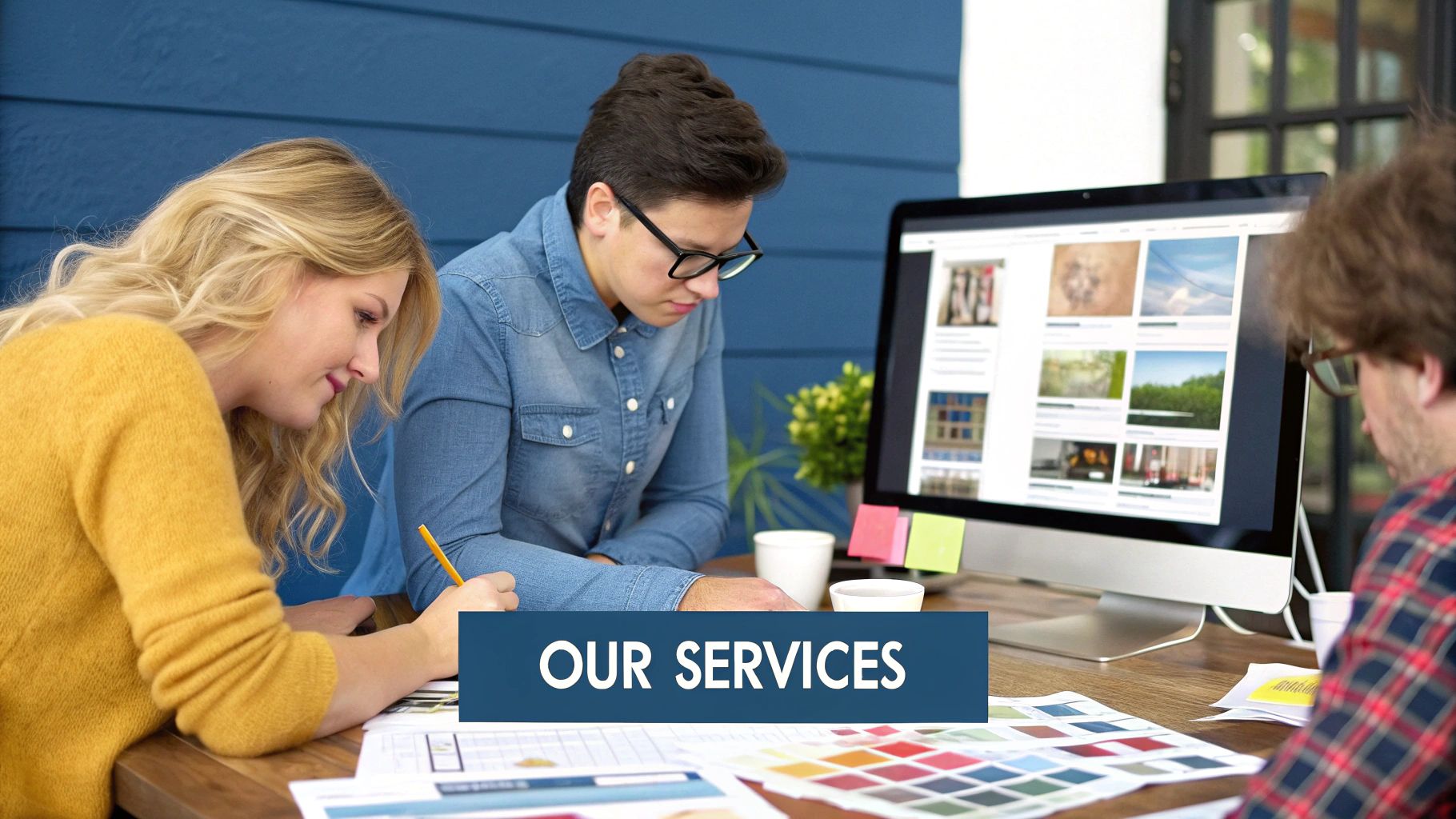
An agency’s portfolio is your window into their world, but you can’t just stop at the view. It’s easy to get wowed by sleek designs and cool animations. The real challenge is figuring out if their work actually works.
A great design is only half the battle. A great website solves business problems. This is where you need to put on your detective hat and separate the digital artists from the true strategic partners.
Your mission is to find cold, hard proof that their designs deliver tangible results. Don’t just scroll through their gallery—you need to dig into their case studies.
Look for Real Business Impact
A beautiful website that doesn’t convert visitors is little more than an expensive, glossy brochure. A results-focused agency knows this, and they’ll be proud to show you the “before and after” stories, complete with real data.
When you’re looking at their past projects, ask yourself a few key questions:
- Do they talk about specific metrics, like a jump in conversion rates or better user engagement?
- Is there any proof of improved organic traffic or higher search rankings after the new site launched?
- Can they actually show a clear return on investment for their past clients?
A standout portfolio isn’t just a collection of attractive websites. It’s a library of success stories, each one backed by data that proves the agency knows how to drive growth and solve real-world business challenges.
Vague claims are a red flag. You want to see specific numbers, like a “200% increase in lead generation” or a “40% reduction in bounce rate.” This kind of data shows they get it—design is a tool for hitting business goals, not just an end in itself. You can see how we present these results in our own website design case studies.
Check Their Technical Chops and User Experience
A website has to work as beautifully as it looks. This means kicking the tires on the technical fundamentals that make for a smooth user experience. The good news is you don’t need to be a developer to spot the basics.
Pick a few websites from their portfolio and open them on your desktop and your phone. Pay close attention to the difference. Is the mobile site just a shrunken, hard-to-use version of the desktop one? Or is it genuinely optimized for a smaller screen?
Keep an eye out for these key technical markers:
- Mobile Responsiveness: Does the site’s layout adapt cleanly to different screen sizes? Are the buttons easy to tap and the text easy to read on your phone?
- Site Speed: How fast do their client sites load? You can use a free tool like Google’s PageSpeed Insights to get a quick performance score. A slow site is a deal-breaker for users and SEO.
- Intuitive Navigation: Can you find what you’re looking for without getting frustrated? Is the menu structure logical?
This technical detail is absolutely critical. For instance, the digital ad market in the MENA region is projected to hit a massive $44,827 million by 2032, driven heavily by mobile use. This trend underscores why agencies must build fast, mobile-first websites that fit how local users actually browse the web.
In the end, looking at a portfolio is all about connecting an agency’s past performance to your future goals. You’re searching for a partner who not only understands your industry but is also obsessed with user-centric design and has a proven track record of delivering measurable success.
Finding a Partner, Not Just a Provider

Technical skills and a stunning portfolio are table stakes. But here’s the thing: they don’t guarantee a project will go smoothly. The best agency relationships I’ve ever seen feel less like hiring a vendor and more like gaining a genuine partner—a team that clicks with yours, gets what you’re trying to do, and is truly invested in your success.
This partnership is built on soft skills, and honestly, they often matter more than pure coding talent. When you’re vetting a potential website design agency, you need to dig into how they work.
Communication is everything. Seriously. Most website projects that go off the rails aren’t because of bad design; they’re derailed by terrible communication.
How They Communicate and Manage Projects
A professional agency will never leave you guessing. They should have a well-defined process that keeps you in the loop from start to finish.
On your first few calls, don’t be shy. Ask them directly about their workflow:
- What tools do you use to manage projects? You’re looking for answers like Asana, Trello, or Jira—systems that can give you a real-time window into their progress.
- How often will I hear from you? A solid partner sets clear expectations, whether that means a quick daily update or a formal weekly report.
- Who is my main point of contact? Having a dedicated project manager who is responsive and accountable is a massive stress reliever.
The right agency doesn’t just build you a website; they guide you through the process. Their communication style and project management are a direct reflection of their professionalism and their respect for your time and money.
You aren’t just buying a finished product. You’re entering a collaboration, and that requires a foundation of trust and transparency. To see how we approach this, you can explore the philosophy behind our team.
Finding Niche Expertise for Your Market
A one-size-fits-all website just doesn’t cut it anymore, especially if you’re in a specialized industry. An agency that already speaks your language—understanding your market’s unique challenges and customer behaviors—gives you a massive head start. This is especially true here in the AE region, where local market nuances can make or break a business.
Think about an e-commerce brand in Dubai. They need far more than a generic online shop. They need a partner with hands-on experience in:
- Arabic/RTL UX: Creating a flawless experience for right-to-left language users is non-negotiable.
- Local Payment Gateways: Integrating payment options that local customers know and trust is crucial for building confidence.
- Regional Data Privacy: Staying compliant with local regulations protects you and your customers.
The demand for these localized skills is exploding. The best web development services in the MENA region are the ones built for local needs, from language to compliance. A partner with this regional expertise brings more than just technical skill; they bring market intelligence that can be the difference between success and failure.
Asking the Right Questions Before You Hire
Once you’ve narrowed your list down to a few promising agencies, it’s time to dig in. The initial calls and meetings are your chance to peek behind the curtain. Are they a genuine strategic partner or just another vendor? Going into these conversations with a solid list of questions is the only way to really understand their process, their transparency, and how invested they’ll be in your long-term success.
This isn’t just about hammering them on price. You need to get to the “how” and “why” behind their portfolio pieces. A top-tier website design agency will not only expect these questions but will have clear, confident answers ready to go.
How Deep Do They Go on Strategy?
The best websites aren’t born in Photoshop. They start with a deep, almost obsessive, dive into your business, your customers, and your market. An agency that glosses over this discovery phase is a huge red flag.
You need to know exactly how they plan to get inside your head and understand your business from the ground up.
- “Walk me through your discovery process.” You’re listening for keywords like stakeholder interviews, competitor analysis, customer journey mapping, and audience research. Anything less is just surface-level.
- “How do you connect our specific business goals to the website’s features and design?” A great answer will show a clear line from a KPI, like ‘increase qualified leads by 20%,’ to a specific design choice or user flow.
- “Who from my team will you need access to, and for how long?” This shows they respect your team’s time and have a clear plan for collaboration.
A thorough discovery process isn’t a “nice-to-have”—it’s the bedrock of a website that actually performs. An agency that invests the time upfront to truly understand your business is an agency that’s invested in getting you results.
Think of the project as a structured journey. A well-defined process ensures every step, from initial strategy to final launch, is built on a solid foundation.
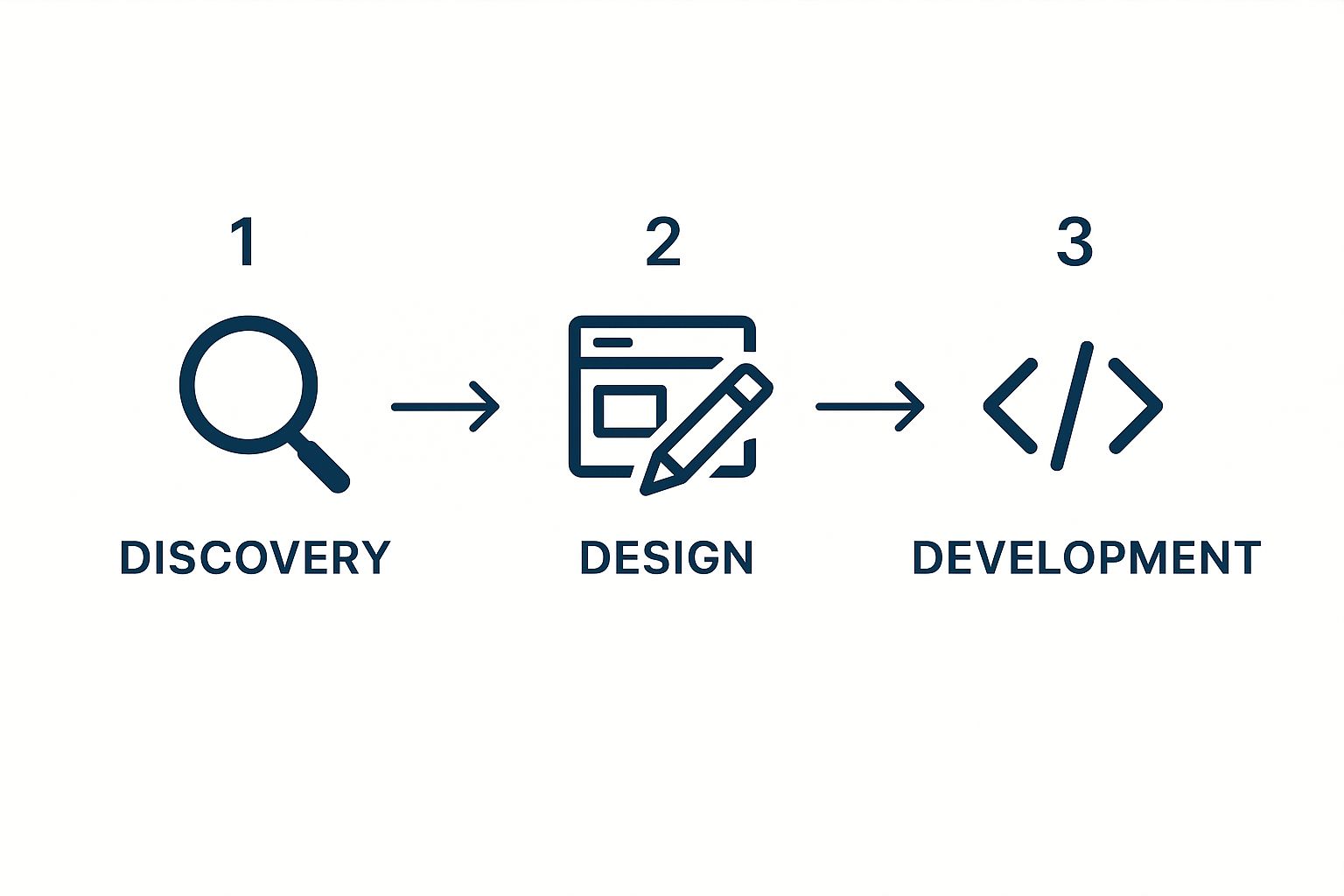
Each stage should logically flow into the next, making sure the final site isn’t just beautiful but strategically sound and technically solid.
Who’s Actually Doing the Work (and What Happens After)?
It’s crucial to know who you’ll be working with day-to-day. The classic bait-and-switch—where the polished senior team makes the sale and then hands your project off to a junior team you’ve never met—is all too common.
Be direct and ask about the people who will live and breathe your project.
- Who will be my main point of contact? Is it a dedicated project manager?
- Can we meet the lead designer and developer assigned to our project?
- Do you outsource any part of the design or development? If so, where and who manages them?
Just as important is what happens after the confetti settles and your new site is live. The launch isn’t the finish line; it’s the starting line. A real partner will have a clear plan for support, training, and maintenance to protect your investment.
Make sure your questions cover the post-launch reality:
- What kind of training will my team receive on the new Content Management System (CMS)?
- What’s your process for handling bugs or issues that pop up after we go live?
- Do you offer ongoing retainers for security, updates, and maintenance?
Agency Vetting Questions Scorecard
To keep things organized, it helps to use a scorecard during your calls. This lets you compare agencies using the same criteria, making your final decision much more objective.
| Question Category | Crucial Question to Ask | What a Good Answer Looks Like |
|---|---|---|
| Strategy & Discovery | How will you translate our business goals into a concrete website strategy? | They connect your KPIs directly to specific website features, content strategy, and user experience (UX) decisions. They talk about data and research, not just feelings. |
| Team & Communication | Who will be our day-to-day contact, and can we meet the core team? | You get a clear answer with names and roles. A great agency will be proud to introduce the talent who will actually be building your site. |
| Technical Expertise | What’s your approach to mobile-first design, site speed, and SEO? | They talk about performance as a core part of their process, not an afterthought. They mention specific tools, best practices, and Core Web Vitals. |
| Post-Launch Support | What happens if something breaks a month after launch? What does ongoing support look like? | They have a defined warranty period for bug fixes and offer clear, tiered maintenance plans. They see the launch as the beginning of the partnership. |
This kind of structured questioning moves you past the sales pitch and into the substance of how an agency operates. It’s this diligence that helps you find a true partner—a website design agency that acts as an extension of your team and is committed to your success for years to come.
Decoding Proposals and Contracts
Alright, you’ve got a stack of proposals. This is where the rubber meets the road. You’re shifting from initial chats to actual commitments, and knowing how to read these documents is the one skill that will protect your investment more than any other.
A good proposal isn’t just a quote—it’s the blueprint for your entire project. The best ones I’ve seen from any professional website design agency are crystal clear. They break down every single phase, from the initial discovery calls and design mockups all the way to development and testing. Each phase should have its own set of deliverables and a timeline. Think of it less as a list of services and more as a strategic roadmap.
You’re looking for a detailed scope of work that leaves zero room for misinterpretation. It needs to spell out exactly what’s included and, just as crucially, what isn’t. Getting this level of detail upfront is your best defense against those dreaded surprise costs and scope creep down the line.
Anatomy of a Strong Contract
When you’ve settled on a proposal, the contract is the next hurdle. This is the legally binding agreement for your partnership, so don’t just give it a quick scan. A few key clauses can have massive implications for your business later on, so pay close attention.
- Intellectual Property (IP) Ownership: This one is non-negotiable. The contract must state, in no uncertain terms, that you own 100% of the final website code and design once the final payment is made. If an agency tries to retain ownership or just license the site to you, walk away.
- Payment Terms: How are payments structured? Tying them to specific, tangible project milestones is standard practice. For example, a deposit to kick things off, another payment after you approve the final designs, and the remainder upon launch. This keeps everyone accountable.
- Exit Clause: What if the relationship sours? A solid contract has a clear exit clause. It should outline the steps for terminating the agreement, what happens to the work-in-progress, and how any final payments are settled. It’s the pre-nup you hope you’ll never need, but you absolutely have to have it.
A transparent contract is the foundation of a healthy client-agency relationship. It’s not about mistrust; it’s about creating a shared understanding of responsibilities, deliverables, and outcomes for both parties.
This kind of diligence ensures you’re starting the project with your eyes wide open, both legally and financially.
Common Questions About Hiring a Web Design Agency
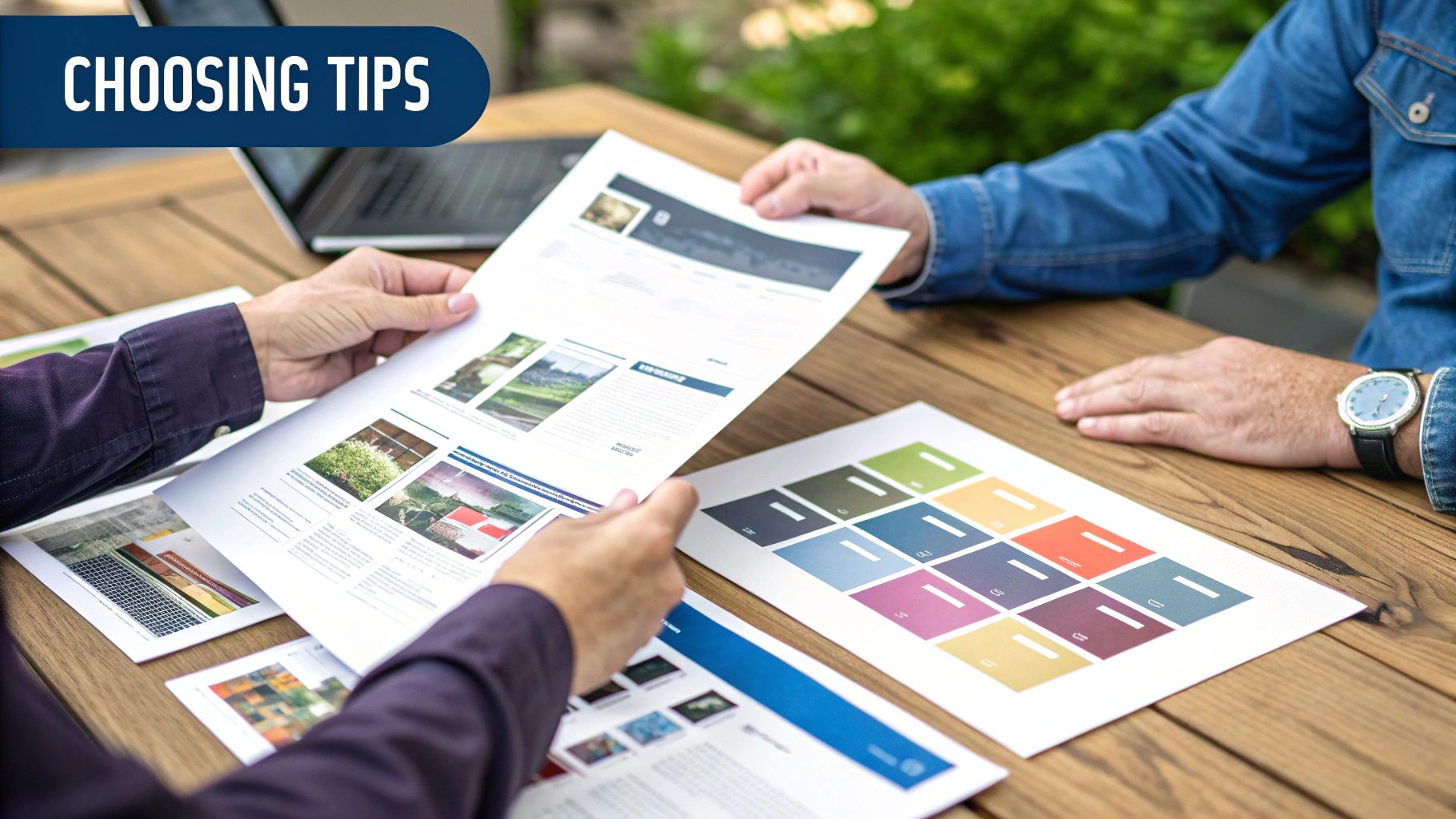
Even with a solid plan in place, you’re bound to have a few nagging questions before you sign on the dotted line. I get it. This is a big investment. Getting clear answers to these common questions will give you the confidence you need to pick the right partner.
How Much Should a Professional Website Cost?
This is the million-dollar question, isn’t it? The honest answer is always, “it depends.”
A straightforward informational site for a local service business might land in the low thousands. On the other hand, a complex e-commerce store with custom integrations and unique features could easily push into the tens of thousands, or more.
Any quality agency worth its salt will insist on a deep discovery call before ever giving you a price. They need to get inside your business, understand your goals, and map out the technical needs before they can put together a meaningful proposal.
A word of caution: be wary of suspiciously low quotes. If a price seems too good to be true, it probably is. It often means they’re leaning on generic templates, outsourcing to junior developers, or cutting corners on strategy and testing. Those “savings” almost always cost you more down the road.
What Is a Realistic Project Timeline?
Great web design doesn’t happen overnight. For a professionally built, custom website, you should realistically expect a timeline of 10 to 18 weeks from kickoff to launch.
This isn’t just arbitrary padding. That time is broken down into critical phases, and each one builds on the last:
- Strategy & Discovery: This is where we dig into your brand, customers, and goals.
- Design: We move from wireframes and structure to full visual mockups.
- Development: The actual code is written to bring the approved designs to life.
- Content Integration: Your text, images, and videos are all loaded into the new site.
- Testing & Launch: We rigorously test everything on different devices and browsers before going live.
If an agency claims they can deliver a fully custom site in just a few weeks, that’s a red flag. They’re either oversimplifying the work or have a very loose definition of “custom,” which can seriously compromise the final product.
What Kind of Support Can I Expect After Launch?
Your website going live is just the beginning, not the finish line. Think of it as the start of a long-term partnership with your agency.
At the very least, you should get a warranty period—usually 30 to 90 days—to fix any bugs that might pop up after launch. You should also receive comprehensive training on how to manage your site’s Content Management System (CMS) so you can update content yourself.
Most professional agencies will also offer ongoing maintenance plans. These retainers are a smart move. They handle essential tasks like security patches, software updates, and regular backups, protecting your investment for the long haul.
Who Owns the Website When It Is Finished?
You do. Full stop.
This is a non-negotiable point. Your contract must state, in no uncertain terms, that upon final payment, you own 100% of the intellectual property. That includes all design files, source code, and everything in between.
If an agency wants to retain ownership or “license” the site to you, walk away. That’s a massive red flag. This kind of arrangement can trap you in a relationship with them forever and create a nightmare if you ever want to switch hosting or work with another developer.
Ready to build a website that doesn’t just look good, but actually delivers results? At Invocom, we blend strategic design with robust development to create digital experiences that fuel growth. Let’s start the conversation about your project today.

